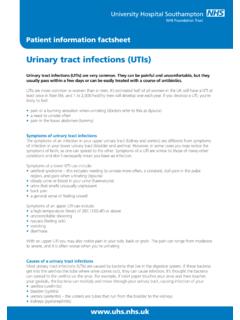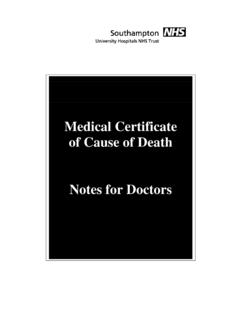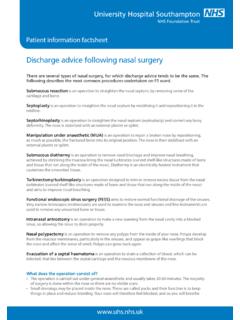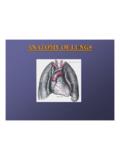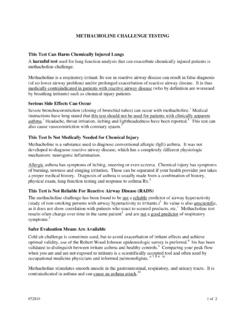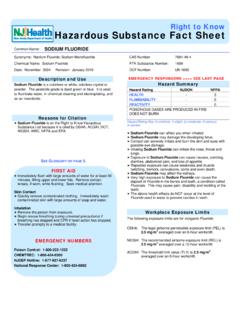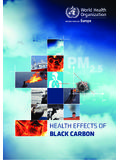Transcription of Pleural biopsy and drainage of pleural effusion - patient ...
1 Pleural biopsy and drainage of Pleural effusionInformation for patientsPleural biopsy and drainage of Pleural effusion4 Information for patients3 This booklet will explain the reasons for the operation, the procedure itself and potential risks involved. It will also explain the care you need before and after surgery. Please feel free to ask any questions raised or not addressed by this booklet. The doctors and nurses are available to support you at this lungs are covered by two thin membranes called the pleura. The space between these two layers is called the Pleural are referred to a thoracic (chest) surgeon for management and/or investigation of symptoms they have been having, which may include increasing shortness of breath and sometimes pain or discomfort and general malaise.
2 Often patients have had a chest x-ray or CT scan that has shown fluid between the two pleura and/or thickening of the pleura. As the fluid builds up it collapses (squashes) the lung. The surgeon is asked to drain the fluid to allow the lung to inflate, however in some patients it is not possible to get the lung fully inflated. The surgeon will also take a biopsy from the pleura to find out why the fluid has collected there. You will normally meet a chest surgeon at a clinic appointment to discuss the reasons for offering surgery, what is involved and any risks associated with the procedure. It is your decision whether or not you have surgery. The doctors and nurses will be available to offer information, advice and support at this time, so please feel free to ask any questions and discuss any concerns you may have.
3 The procedure The operation is normally done under a general anaesthetic, although occasionally in some circumstances it is done under a local surgeon may sometimes do a bronchoscopy first, using a telescope to look into the windpipe and airways. The surgeon will then make one, two or three small cuts on the chest about two to four centimetres a special telescope the surgeon will look into the Pleural space and then drain the fluid off, as well as taking biopsies from the membrane. In some patients the surgeon will put some sterile talc into the Pleural space to stick the two membranes together to try and prevent the fluid returning. The surgeon will need to leave a chest tube in the space to drain any air and fluid after the operation.
4 The drain will need to stay in place for about two to three days. Once the drain has been taken out the stitch will need to be removed seven to ten days later, by your local surgery nurse or the district operation usually takes 45 minutes to one biopsies will be sent to the laboratory for analysis. This normally takes ten to 14 to the planned surgeryFor technical reasons the surgeon may be unable to do your operation using the telescope and may therefore have to extend one of the cuts or make a new, longer cut to complete the operation. This is called an open Pleural biopsy . Very occasionally if there is bleeding during the operation that cannot be controlled through the telescope, the surgeon will need to make one of the cuts larger to gain direct vision and control the for patients5 Pleural biopsy and drainage of Pleural effusion4 Preparation for surgeryYou may be admitted to hospital day before your operation, or on the day reduce the risk of infection, you will need to have a bath, or shower in an antiseptic solution the night before your operation.
5 We will give you this special liquid must not eat anything after midnight the night before your operation. After midnight you can only drink water, and you must stop this at you take any medications the nurses will advise you which you may take before your admission you will need to have the following tests. Blood tests ECG heart tracing Chest x-ray A full set of observations - blood pressure, pulse, oxygen levels, temperature, respiratory rate, weight and heightOn the morning of your operation you may need to have your chest, back and underarm shaved with special clippers. You will need to have another bath, shower, or full wash and a hair wash in the antiseptic solution.
6 After this you will be asked to put on a hospital gown. We will also give you compression stockings to wear, which help to prevent you developing blood clots in your legs. All patients are screened for MRSA on admission by doing a nose and groin nurse will need to complete some paperwork with you and a doctor or nurse specialist/practitioner will take a medical history and do an examination. This may have been done in a pre-admission anaesthetist will see you to discuss having a general anaesthetic. We do not routinely give pre-medications; however if you are particularly anxious then please mention this to the you need other tests specific to you these will be procedure will be explained to you again and any questions you may have will be everything has been completed a doctor will ask you to sign a consent form giving your permission (consent) for the operation to take place.
7 Before your operation a doctor will mark the side you are to be operated on. Please let a member of staff know if this gets washed will give you two name bands to wear, with the ward, your name, date of birth and hospital number. If you are allergic to anything you will also need to wear a red band. Please let a member of staff know if you lose one, or if any of the information is going to theatre the nurses will complete a check-list with you. This will be repeated several times when you go to theatre. This is for your the operationAfter the operation you will be taken to the recovery room. The staff will be constantly monitoring you and making you comfortable.
8 Once they are happy with your condition you will return to the ward. You will normally stay in recovery for about two hours. Some patients will have a chest you get back to the ward you will be closely monitored for the first part of your will have oxygen via a mask which will need to stay on for at least the first few hours. You will not be able to drink for four hours after your operation, so you will have fluids given by a tube going into a vein until you can drink chest drain normally stays in for 48 to 72 hours depending on how much drainage there is and if there is an air leak. The nurses will be measuring the amount of drainage from your drain. With a chest x-ray and this information the doctors will decide when the drain can be you may have a tube in your bladder to measure your urine; this will normally be removed the following will be shown how to do breathing exercises and how to cough to prevent a chest infection, as well as exercises to prevent getting a frozen Information for patients7 Pleural biopsy and drainage of Pleural effusion6shoulder or a blood clot.
9 It is very important to do these exercises as they will help with your reliefAfter your operation you will need to have some pain relief. This is normally by patient controlled analgesia (PCA), a device designed to ensure you receive safe levels of pain relief. It consists of a syringe containing pain relief medication, attached to a vein in your arm. When you require pain relief you press a button to release a dose. This allows you to be in control of your own pain relief when you need it. As your pain improves you will be given tablets and the PCA and local anaesthetic will be nursing staff will be monitoring your pain levels so please tell them if your pain is not care You will need help to begin with but gradually you will be able to do more for can eat the following day but expect to have a poor appetite to begin majority of patients having this surgery will find they are able to start walking around on the first day after their operation.
10 Gradually as you recover you will be expected to move more, but be careful not to overdo it. The nurses will help you decide how much you should will have dressings over your wounds and these will be removed 24 to 48 hours after the operation. The dressing around the drain will need to stay on while the drain is in place and then for about two days after the drain comes out. Dressings are normally changed on alternate days or more frequently if necessary. We would hope that by the time you go home you will be comfortable and gently walking around the ward. Your pain should be controlled on tablets, and you should be able to shower or wash yourself and get yourself dressed.



